
Look at these 8 items to see if a T-shirt quilt is well made:
1. Seam Construction
2. Sewing Accuracy
3. Backing Material
4. Quilting
5. Batting Loft
6. Binding
7. Feel
8. Over All Look
Are you planning on having a quilt made from your T-shirts? The research you do now will help you find the quilter best suited to make your quilt. You have one chance to have your quilt made right.
If you are not a quilt expert, you might not know what to look for when you see a T-shirt quilt. Don’t take someone’s word that they make high quality T-shirt quilts; look at their work with a critical eye. Below is what to look for and why.
Here are 8 items to check out when you are looking at a T-shirt quilt.
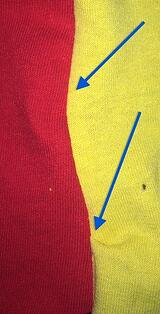
1. Seam Construction
Where two pieces of material are sewn together it is called a seam. It would be great if you could look inside a quilt to see the seam. But, you can't. So you will need to look at the face of the quilt to judge the construction.
First, look for seams coming apart. This is a sign that the quilter is either not starting or stopping correctly or that their sewing machine stitch is not correct. Either reason, this is a flag to which you should pay attention.
Second, look to see if the seam is straight. If the seam is not straight, it means that the sewer did not follow along the edges of the material straight. This could jeopardize the long term viability of the seam.
2. Sewing Accuracy
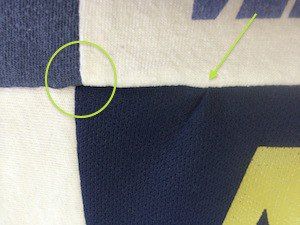
There are three place to look at sewing accuracy. The four corners, tucks along the seam and puckers along the seam.
Four Corners
Look at the intersection of four blocks. Do they come together perfectly? If not, this is a sign of sloppy work that could have been easily fixed. If a quilt maker did not take the time to fix this, it's a sign that there might be other parts of the quilt you can't see that she did not fix.
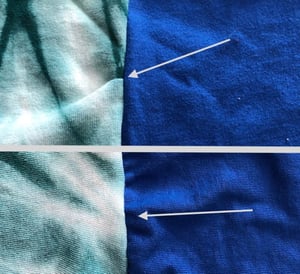
Tucks
Look long the seam for tucks. A tuck happens when there was more fabric on one side of the seam than the other. This could be because the blocks were not cut accurately. It could be because the material on side was stretched too much. It could be because the quilt maker does not have the right equipment.
For whatever reason, tucks should be fixed before a quilt is completed.
Puckers
Are the seams puckered? A pucker is different than a tuck. In first the photo here, the tuck is at the top. A tuck is when the fabric is fold over on itself in the seam.
A pucker is when you have more fabric on one side of the seam than the other. You can stretch the short side to make it fit to the long side. When you do this, puckers develop. It makes the seam look wrinkly. The example of puckers is at the bottom of the photo here.
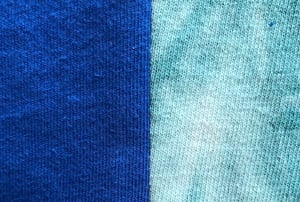 T-shirt material can be challenging to work. Seams that do't meet, tucks and and puckers are a sign of inexperience, lack of attention to details or the wrong sewing machine.
T-shirt material can be challenging to work. Seams that do't meet, tucks and and puckers are a sign of inexperience, lack of attention to details or the wrong sewing machine.
The photograph here shows is what a good seam looks like. A good seam is straight and flat. No tucks or puckers.
A good quilt makers will fix tucks, puckers and blocks not coming together perfectly. A lazy or unskilled quilt maker will not.
In the quilt here, there are arrows point to how these look in a quilt. This quilt was not made by Too Cool T-shirt Quilts.
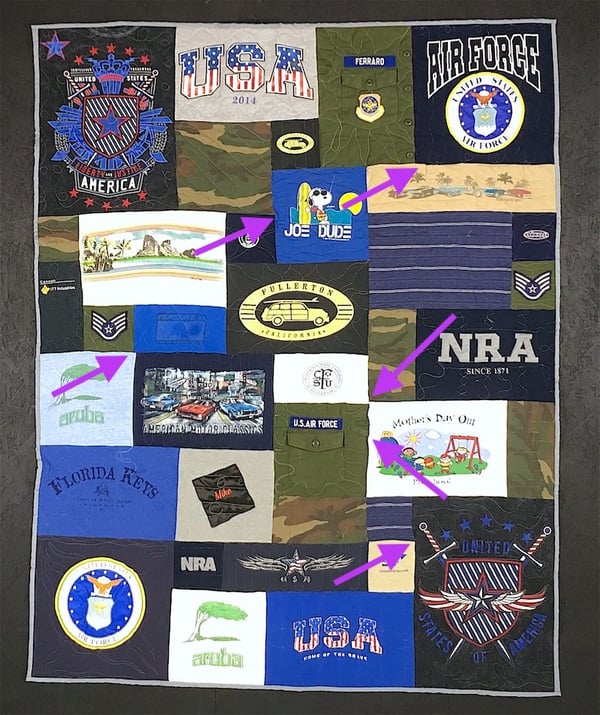
Discover more about having a quilt made with your T-shirts. Consider downloading our T-shirt Quilt Buyers Guide.
It's will help you know what you want your quilt to look like and what to look for in a quilt maker. 
3. Backing Material
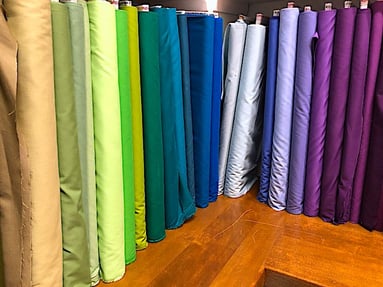
A quilt can be well made, but if a cheap material is used, it can effect your quilt. It can make the quilt feel and look cheap.
Feel the backing fabric. Do you like the feel of it? Ask the quilt maker if there is polyester in the fabric. Polyester fabric will pill. This means that it will develop those little balls on the surface of the material. This will make the back of your quilt look bad. And it will feel bad.
You should look for a quilt maker that uses 100% high quality cotton backing material. If you are unsure, ask. Cheap backing material is a place where quilters can skimp to save money. Read more about backing material here.
4. Quilting
Quilting is the stitching that holds the front, batting (stuffing) and backing fabric together. If there is nothing connecting the front to the back, you then have a blanket.
There are two considerations when you are looking at quilt - stitch length and density.
Stitch Length
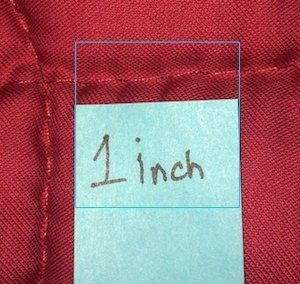
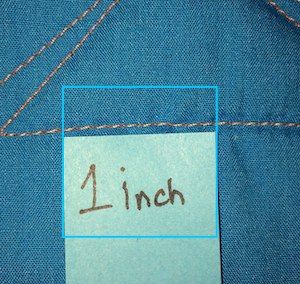
In the quilting world, stitches are measured in "stitches per inch."
A quality T-shirt quilt will be quilted with 10 or 11 stitches per inch. In the photo here, the blue one is quilted in 10 stitches per inch.
The red one is quilted 4 to 5 stitches per inch.
Quilts with long the stitches look bad. And the stitches can more easily come out.
Why would a quilt maker use long stitches? To save time. If you use half as many stitches, you can cut the time it takes to quilt a quilt in half. This is a place some quilt makers can cut cost.
Density
Quilting density is how closely or spread out the stitching is. Take a look at the photo here. The quilt on the left has a much greater density than the quilt on the right. The quilt on the right has 5 rows of quilting with very long stitches. That is not a lot of quilting.
Why does it matter how much quilting a quilt has? The quilting does holds the front and back together. But more importantly, it helps keep the batting in place. The batting is the stuffing in the middle of the quilt.
Every type of batting requires a specific quilting density. The quilt on the right uses 1" 100% polyester batting. The manufacture says that this requires quilting distance of 2 to 4 inches. This quilt does not have enough quilting. There are un-quilted areas that are much larger than 4" x 4".
Why does that matter? If a quilt is not quilted close enough, the batting will wad up when the quilt is washed. The result is a lumpy quilt. So the density of quilting matters.
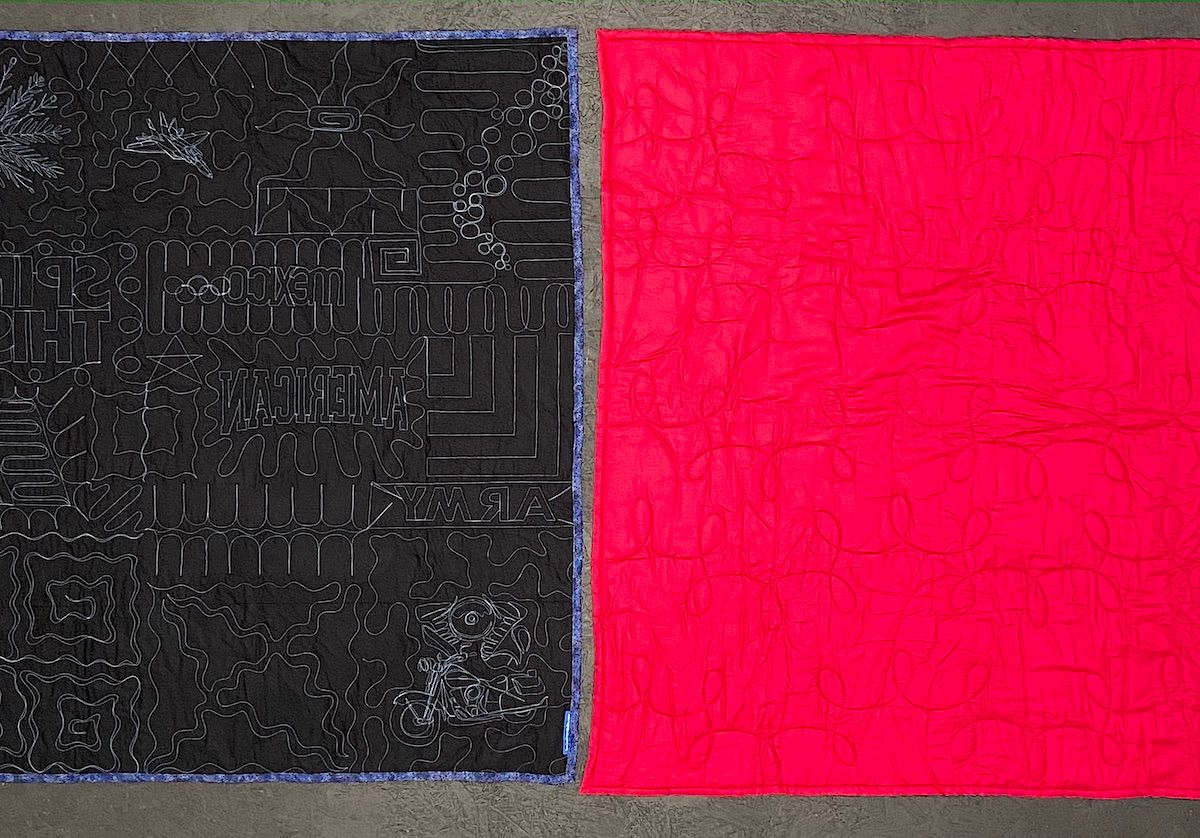
5. Batting Loft
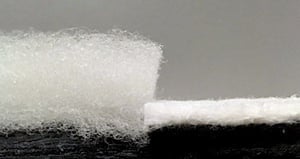 Loft is how a quilter describe the thickness of batting. Thicker is not better! Thick can be very bad!
Loft is how a quilter describe the thickness of batting. Thicker is not better! Thick can be very bad!
Experienced quilt makers use batting that is about ¼" tall. In the photo here, the good batting is on the right. The best battings are either 100% cotton or 80% cotton/20% polyester.
Be wary of any batting thicker than ½". The taller the batting, the more likely it is 100% polyester. 100% polyester batting is cheap, miserable stuff – if at all possible, avoid it! If you are unsure which batting a quilt maker is using, ask!
We have an article all about batting here.
6. Binding

The binding is the material that goes around the outside of the quilt. It covers the raw edges of the quilt top, the batting and the backing. The first photo here shows the raw edge that the binding will cover.
If a quilt does not have a binding, it's not a quilt. It's a blanket.
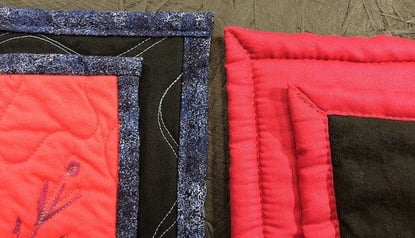
What type of binding is used on the quilt you are looking at? There are two main styles of binding.
1. Half binding - In this method, the quilter brings excess backing material around to the front of the quilt. It is then sewn down. In the photo here, the half binding is on the right. The pink binding and backing fabric.
2. Strip Binding or a Full Binding - The binding is made from a separate piece of material. This binding is sewn onto the quilt in two steps and is two layers thick. This is the best style of binding for a T-shirt quilt. In the photo here, the quilt on the left has a blue full binding.
If you have a choice, the better choice is the full binding. Read more about bindings here.
7. Feel
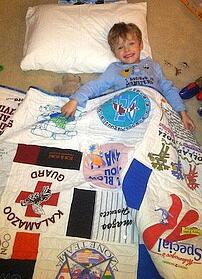 Is the quilt soft and flexible? A T-shirt quilt should move similarly to a T-shirt.
Is the quilt soft and flexible? A T-shirt quilt should move similarly to a T-shirt.
If the T-shirts in a quilt look flat and smooth, this is a sign they were backed with iron-on backing. Also called interfacing.
Iron-on backing make it easier for the quilt maker to sew the T-shirts. But you don’t gain anything from iron-on backing except a stiffer quilt. Avoid quilters who use iron on backing or stabilizers. By doing so, you will avoid a stiff quilt.
Read more about iron-on backing here.
8. Over All Look
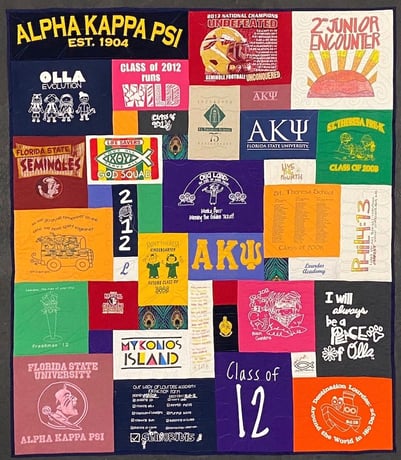
Do you like the over all look of the quilt? Does the quilt catch your eye and draw you into the quilt? Can you envision your T-shirts in a quilt like this?
Finding someone to make your T-shirt quilt can take some research. First, look at the over all appearance of their quilts. Do you love them? If so, then consider the other quality aspects explained above.
Read more about finding a T-shirt quilt maker here.
Remember, we are happy to make a quilt for you here at Too Cool T-shirt Quilts. Here's the starting place.
See more photos of T-shirt quilts here.
If you treasure your T-shirts, they deserve to be made into a high quality T-shirt quilt that will last a lifetime or three!
For more information about T-shirt quilts, consider downloading our T-shirt Quilt Buyer’s Guide.
The more you know about T-shirt quilts, the better your quilt will be.
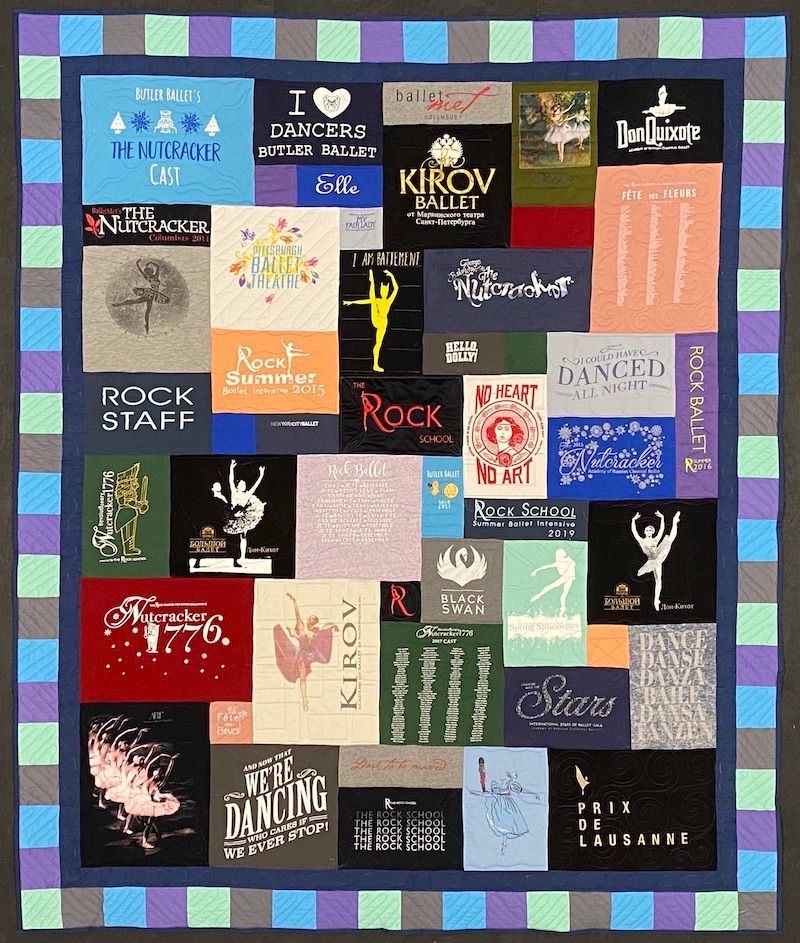
Andrea Funk is the inventor of T-shirt quilts made with multiple blocks sizes. The modern method of making T-shirt quilts. In 1992 she founded Too Cool T-shirt Quilts. Her life has been immersed in T-shirt quilts ever since.
